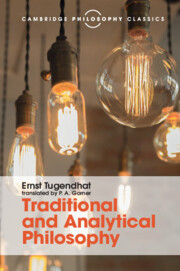Book contents
- Frontmatter
- Dedication
- Contents
- Preface
- Preface
- Translator's preface
- Part I Introduction: confrontation of analytical philosophy with traditional conceptions of philosophy
- Part II A first step: analysis of the predicative sentence
- 8 Preliminary reflections on method and preview of the course of the investigation
- 9 Husserl's theory of meaning
- 10 Collapse of the traditional theory of meaning
- 11 Predicates: the first step in the development of an analytical conception of the meaning of sentences. The dispute between nominalists and conceptualists
- 12 The basic principle of analytical philosophy. The dispute continued. Predicates and quasi-predicates
- 13 The meaning of an expression and the circumstances of its use. Dispute with a behaviouristic conception
- 14 The employment-rule of an assertoric sentence. Argument with Grice and Searle
- 15 Positive account of the employment-rule of assertoric sentences in terms of the truth-relation
- 16 Supplements
- 17 ‘And’ and ‘or’
- 18 General sentences. Resumption of the problem of predicates
- 19 The mode of employment of predicates. Transition to singular terms
- 20 What is it for a sign to stand for an object? The traditional account
- 21 The function of singular terms
- 22 Russell and Strawson
- 23 What is ‘identification’?
- 24 Specification and identification. Specification and truth
- 25 Spatio-temporal identification and the constitution of the object-relation
- 26 Supplements
- 27 Results
- 28 The next steps
- Bibliography
- Index of names
- Index of subjects
23 - What is ‘identification’?
from Part II - A first step: analysis of the predicative sentence
Published online by Cambridge University Press: 05 August 2016
- Frontmatter
- Dedication
- Contents
- Preface
- Preface
- Translator's preface
- Part I Introduction: confrontation of analytical philosophy with traditional conceptions of philosophy
- Part II A first step: analysis of the predicative sentence
- 8 Preliminary reflections on method and preview of the course of the investigation
- 9 Husserl's theory of meaning
- 10 Collapse of the traditional theory of meaning
- 11 Predicates: the first step in the development of an analytical conception of the meaning of sentences. The dispute between nominalists and conceptualists
- 12 The basic principle of analytical philosophy. The dispute continued. Predicates and quasi-predicates
- 13 The meaning of an expression and the circumstances of its use. Dispute with a behaviouristic conception
- 14 The employment-rule of an assertoric sentence. Argument with Grice and Searle
- 15 Positive account of the employment-rule of assertoric sentences in terms of the truth-relation
- 16 Supplements
- 17 ‘And’ and ‘or’
- 18 General sentences. Resumption of the problem of predicates
- 19 The mode of employment of predicates. Transition to singular terms
- 20 What is it for a sign to stand for an object? The traditional account
- 21 The function of singular terms
- 22 Russell and Strawson
- 23 What is ‘identification’?
- 24 Specification and identification. Specification and truth
- 25 Spatio-temporal identification and the constitution of the object-relation
- 26 Supplements
- 27 Results
- 28 The next steps
- Bibliography
- Index of names
- Index of subjects
Summary
At the end of the lecture before last we arrived at the result that the function of singular terms is to be understood as that of specifying. By ‘specifying’ was meant: indicating which of all objects it is that is classified by the other sentence-component. It has not yet been decided whether the meaning of our reference to objects is exhausted by the thus characterized object-relation that is made possible by the employment of a species of linguistic sign, nor whether we are to understand what is meant by ‘objects’ in terms of it. And in particular it remained still unexplained how these linguistic expressions – singular terms – must be employed if they are to be able to fulfil the function of specifying as thus described.
In order to prepare ourselves for this enquiry into the concrete form which the specificatory function of singular terms takes we shall begin by orientating ourselves towards the conception of Strawson (who was the first to tackle this problem). We saw in the last lecture that one cannot be satisfied with the way in which Strawson, in his early paper ‘On Referring’, tries critically to distinguish himself from Russell. However, his own positive conception (viz. that singular terms have a so-called identificatory function) is merely sketched in that paper. It is only worked out in his book Individuals (1958) and in his paper ‘Singular Terms and Predication’ (1961) in which he argues with Quine. So it is these writings towards which we must orientate ourselves in the hope of reaching, via Strawson's talk of identification, a concrete understanding of what I have termed the function of specification.
In the 1961 paper Strawson states that it belongs to the essence of a singular term that it is ‘used for the purpose of identifying the object’. And this identificatory function is said to consist in ‘bringing it about that the hearer knows which object it is, of all the objects within the hearer's scope of knowledge or presumption, that the other term’ – the predicate – ‘is being applied to’. This definition of what is meant by ‘identification’ comes very close to the definition which I have given of ‘specification’; one might therefore think that they stand for the same concept. However, as we shall see, the matter is more complicated.
- Type
- Chapter
- Information
- Traditional and Analytical PhilosophyLectures on the Philosophy of Language, pp. 321 - 333Publisher: Cambridge University PressPrint publication year: 2016



